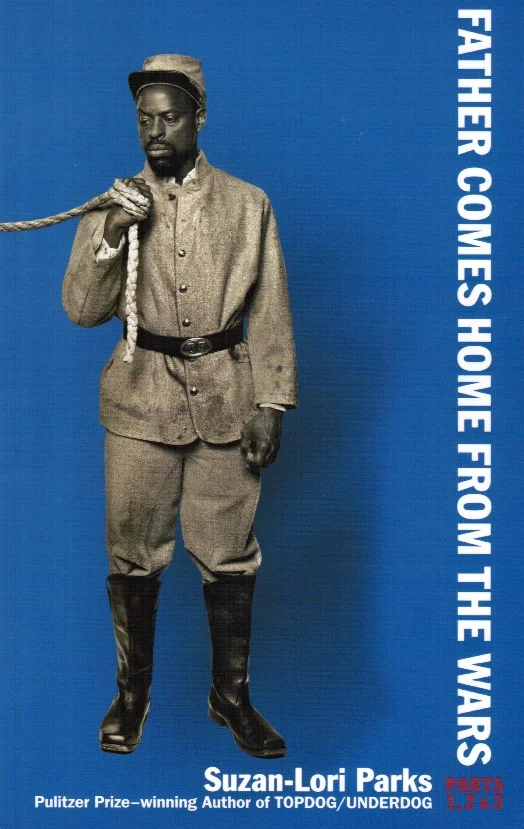Nottage. SWEAT.
O’Brien, Dan. The Body of an American.
Publisher: Oberon, 2014.
World Premiere: Portland Center Theatre, n.d. European Premiere: Gate Theatre, Northampton, England, 2014
Locations: Scenes 1-7 take place in various places around the world. Scenes 8-10 take place in Alaska.
Characters: Dan (30) & Paul (50) plus many others, all played by 2 actors.
Scene 1. Fresh Air: On NPR’s Fresh Air with Terry Gross, Paul Watson tells the story of taking the iconic photo of Staff Sgt. William David Cleveland’s body being desecrated by a mob in Mogadishu (1993). As he takes the picture, he hears Cleveland say, “If you do this, I’ll own you the rest of your life.” Playwright Dan O’Brien is also introduced.
Scene 2. Who Was He Talking To?: Dan talks about living a privileged life in Princeton; Paul talks about being a misfit who feels like he’s already died.
Scene 3. Q & A. Or, Got to Go: As Paul jet-hops from crisis zone to crisis zone and Dan teaches writing in Madison, they carry on an email conversation about their fathers, etc., with primary focus on Paul’s background, his malformed arm, his drug use, etc.
Scene 4. The Ghosts Are Getting Closer: Paul talks about covering the Rwandan massacres and then abruptly attending a Pulitzer prize award ceremony where photo journalist Carter wins a prize just before committing suicide.
Scene 5. Shrinking: Paul has a therapy session with Dr. Grinker, a Johannesburg psychiatrist. He tells about his relationship with the nymphomaniacal Khareen and about hearing Cleveland speak to him while he shot his picture.
Scene 6. Iraq. Paul tells about being attacked by a mob in Mosul and about thinking Cleveland would be happy.
Scene 7. Some Embarrassing Things. Or, The Plan: Goaded by Paul, Dan tells about his alienation from his family. They make plans to meet in Alaska.
Scene 8. Hi What’s Your Name When Are You Leaving?: Dan flies to Kugluktuk and meets Paul. They try to figure out what to do. Boredom reigns in Kugluktuk.
Scene 9. Blizzard: They go out sledding with Inuits Jack & Jerry, and Dan is hurt in a run-away-dog sledding accident. Paul tells about the death ofAbdul Haq at the hands of the Taliban in Pakistan.
Scene 10. Yellowknife: Dan is still searching for an ending to Paul’s play. Paul tells about contacting Cleveland’s mother and brother. Paul and Dan part in Yellowknife. Paul emails Dan from Kabul.
OBSERVATIONS
The Body of an American takes the form of a long poem (written in free verse) for two voices. While one actor primarily plays Dan and the other primarily plays Paul, the two alternate with each change in lines; this means that sometimes Paul will be speaking, and then there’s a new line indication and the other actor takes up Paul’s speech. Different characters of different nationalities and identities have lines without any indication of their identity (except in the script’s speaker designations). On the one hand, this approach would likely be confusing to the audience; on the other hand, the identities of the speakers are not particularly germane to the play’s effect.
The play is to be done with projections, and specific slides are indicated in the script’s margins. Some of the suggested photos are printed in the back of the book.
The play is primarily imagistic rather than mimetic. It doesn’t so much tell a story as give a kind of scrap-book like depiction of Paul Watson and, in particular, his obsession with his photo of American soldier Cleveland’s body being dragged through the streets of Mogadishu. It reminds me of one of Spalding Gray’s one-person plays done by two actors. Body is in many ways an extreme sample of a language play, as described by Castagno.
Motifs: ghosts. Camus. The title of Paul Watson’s book that inspired the play—Where War Lives—and Camus’ answer that war lives in each of us.
The narrative mode facilitates jumping back and forth between dates and places. The play has affinities with Wright‘s I Am My Own Wife. Both plays are about the interviewing and collecting of materials for a play, both are bio-dramas, both feature the playwright as a major character, both have multiple characters played by male actors (a single actor in the case of Wife). Since O’Brien’s play followed Wright’s by a decade, it’s likely O’Brien took formal cues from Wright’s play.


